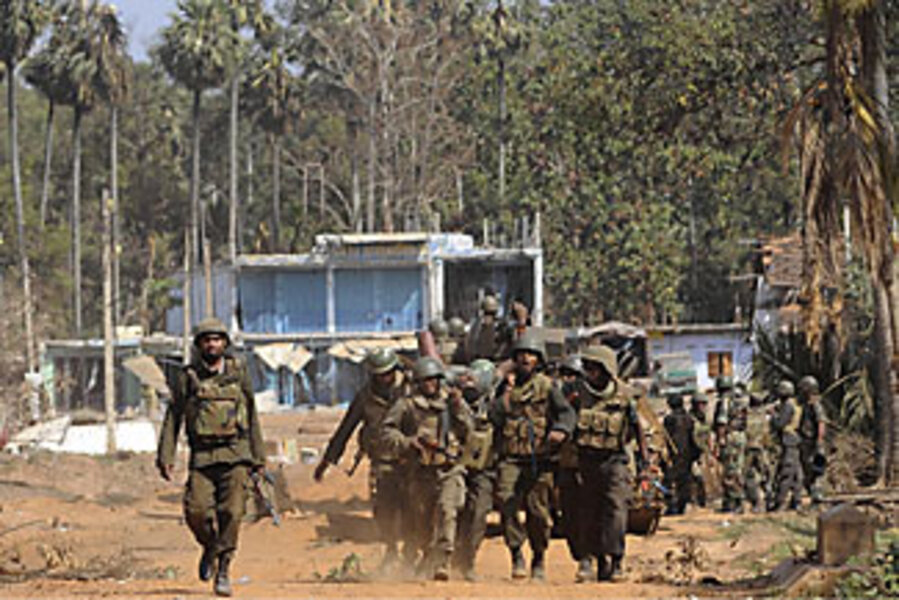Sri Lanka: If war ends, can a divided nation heal?
Loading...
| HATTON, SRI LANKA
The long, bloody civil war never came to this market town, deep in the tea-growing highlands. No suicide bombings. No Army massacres.
But the anger and alienation that fed a generation of revolt by Sri Lanka's Tamil minority still burn here, far from the battlefields of the north. Everyday hassles, not the struggle for self-rule, are largely to blame: racial profiling by abusive police; few Tamil-speaking bureaucrats; official documents issued only in Sinhalese, the language of the majority.
Such discrimination undercuts any promise of pluralism to heal a divided nation, says P.P. Devaraj, a retired Tamil lawmaker. Divisions are also found within the Tamils, who split along north-south lines based on migration patterns. But the deepest fault line – and the crux of the conflict – is between Sinhalese and Tamils. "The feeling on the part of the Sinhalese majority is that the country belongs to them, that Tamils must realize this is a Sinhalese country," he says.
After 26 years, the military appears close to victory over the Liberation Tigers of Tamil Eelam (LTTE), which seeks a ministate in this Indian Ocean island. The group's fighters are pinned down in a shrinking northeast corridor, along with hundreds of thousands of Tamil civilians.
Many Sri Lankans see the all-out fight against the Tigers as the only way to end the war, whatever the cost. Politicians who question this are drowned out by those seeing a bright future for a war-weary nation after the defeat of Tamil terrorism.
But ending a cycle of ethnic conflict may prove much harder than a military victory. Even among Tamils who reject its violence and political goals, the LTTE's apparent near-defeat leaves a bitter taste. Few are ready to trust a Sinhalese-dominated government to roll back decades of discrimination. "It's like a train. There's first class, and there's second class," says Odaya Ramiah, a veteran organizer of Hatton tea-estate workers.
The roots of the conflict go back to the early days of independence in 1948 from British colonialism. Feeling excluded by an English-speaking elite, Sinhalese sought official language status. The 1956 "Sinhala Only" law drove a wedge between the Sinhalese-dominated south and Tamils in the north, leading to demands in the 1970s for federalism that morphed into armed revolt.
Government officials say language policy has since been changed to include Tamil, which is taught in some public schools. Tamils worship freely at Hindu temples and Christian churches (most Sinhalese are Buddhist). They argue that far from being an oppressed people – as the LTTE claims – Tamils have excelled in business and many live comfortably in the capital, Colombo.
"If there is genocide and killing of Tamil people, why are Tamils coming to Colombo?" asks Gotabhaya Rajapaksa, the country's defense secretary.
But once in Colombo, Tamils must register with police, unlike Sinhalese. At ubiquitous checkpoints, Tamils are singled out. Infrequent abductions – a hallmark of Sri Lankan counterinsurgency campaigns – add to the sense of insecurity.
Such worries seem remote from Hatton's tea estates, part of an industry that is Sri Lanka's most lucrative export. Tamils in grimy clothes trudge up the steep slopes to prune and pluck the dark-green leaves sold to buyers in Russia and the Middle East. There are fewer Army checkpoints on roads and less talk of war.
But Tamil men here still run the risk of being hauled in as LTTE suspects. Once in police custody, they must sign statements in Sinhalese, says P. Mohan Subramaniyam, a Tamil community worker. Any complaints about ill-treatment must also be filled out in the same language.
Sinhalese make up 74 percent of a population of 20 million, compared with 18 percent for Tamils. In tea-growing districts like Hatton, the mix is reversed. But Sri Lankans distinguish between "Indian Tamils," brought in by the British as plantation workers, and Tamils in the north and east with longer lineages.
Cut off by history and geography, Indian Tamils never embraced the LTTE's dream of self-rule. Their leaders bargained for higher wages and sided with Sinhalese-dominated governments. But that doesn't stop Tamils from wincing at wartime patriotism, says Mr. Subramaniyam. "When I talk to Sinhalese, they tell me that when the Tigers are destroyed we will be free. But I feel that we only live with dignity because the Tigers are there," he says.
Violence threatened Hatton in the late 1980s. But it was the JVP, a Sinhalese militant group, that torched tea factories here as part of an uprising that swept the south. Tens of thousands died, many killed by state-backed paramilitaries. These deaths aren't counted in the oft-cited estimate of more than 70,000 killed since 1983 in the conflict with the LTTE.
Intra-ethnic conflict has also scarred Tamils: the LTTE wiped out several rival militant groups in the 1980s and has since assassinated leaders who switch sides. Government officials claim the LTTE has visited more bloodshed on Tamils than have the security forces.
At his teashop in Kitulgala, Ananda Ratnasiri says Tamils have equal rights and no reason to complain. Like many Sinhalese, he believes a peace dividend is near. "We want to end the war and defeat terrorism," he says. "Then we can extend government services to everyone."
• Tomorrow: How the global war on terror shaped Sri Lanka's battle.





